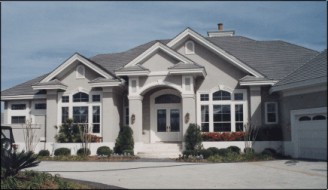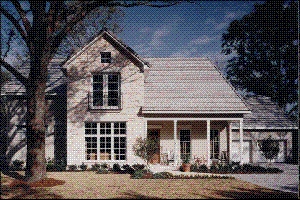
From Florida to Minnesota, traditional stucco is a proven system that works in all climates.
Traditional portland cement plaster (stucco) is a time-tested exterior finish. It consists of portland cement-based materials and sand, mixed with water to form a workable plaster. Portland cement, the same material that is the basis for the hardened properties of concrete used to build super-highways, bridges, and skyscrapers, provides strength, durability, and toughness in portland cement plaster.
Stucco, or portland cement plaster, is a versatile facing material that can be applied to flat or curved surfaces either inside or outside any building or structure. Stucco has great appeal as a surface finish because of its utility, low first cost, and minimum need for maintenance.
In its hardened state, plaster is a desirable facing material: hard, strong, fire-resistant, and color-retentive. Because plaster is also breathable, or able to transmit moisture vapor, water that gets behind it does not become trapped. That makes it resistant to rot and fungus. Plaster has proved to be a durable wall cover in all climates, whether wet, dry, hot, or cold.
The final appearance of the finish coat can be varied by changing the size and shape of the aggregate, using colored cement, adding pigments, changing the consistency of the finish mix, the method or equipment used for plastering, and the plasterer's skill in manipulating the finish coat.
Portland cement plaster is applied either by hand or machine to exterior and interior wall surfaces in two or three coats. It may be applied directly to a solid base such as masonry or concrete walls, or it can be applied to a metal lath attached to frame construction, solid masonry, or concrete construction.
Applied directly to concrete masonry, Portland cement plaster provides a tough 1/2-inch thick facing that is integrally bonded with the masonry substrate. When applied to metal lath, three coats of plaster form a 7/8-inch total thickness. A vapor-permeable, water-resistant building paper separates the plaster and lath from water sensitive sheathing or framing. Portland cement plaster has high impact resistance, sheds water, but breaths, allowing water vapor to escape. It’s a proven system that works in all climates.
Traditional Stucco is Strong and Beautiful
Traditional portland cement stucco provides a tough exterior that resists attack from hazards ranging from woodpeckers to weed whackers. That inherent toughness is beautifully complemented by the variety of colors and textures available. Appearance is an important consideration in selecting a wall covering (cladding). You can select a color and texture consistent with the message and image you wish to convey.

Traditional stucco provides a strong, beautiful, low maintenance finish.
Color is determined by selecting cement and aggregate color, and quite often modified by adding mineral oxide pigments to the plaster mix. In many areas, factory-prepared finish-coat products are available. Pre-pigmented packaged cements also can be used to achieve the desired stucco color or pre-weighed mineral oxide pigments can be added to the finish coat stucco during mixing.
Texture is achieved by selecting aggregate size, controlling finish mix consistency, and using special treatment techniques during and after application of the finish coat plaster. Texture gives substance and character to the plaster surface. It can be used to provide highlights, depth, continuity, segmentation, and even achieve the look of a completely different construction material such as wood timbers, brick, or stone masonry construction. To confirm the suitability of a desired color and texture, be sure to ask your plasterer to provide a sample panel for evaluation prior to starting work.
Portland cement plaster has a well documented history of proven performance in extreme climates from the desert southwest of Arizona, to the severe winters of Minnesota, to the hot-humid Florida summers. It performs in all climates.
That durability is complemented by its versatility. Portland cement plaster provides an ideal finish or cladding for any building construction system including concrete, concrete masonry, brick masonry, wood frame, or steel frame. Portland cement stucco can be applied to any flat or curved surface either inside or outside.
Don't Mistake Traditional Stucco for "EIFS"
Portland cement plaster should not be confused with the exterior insulation and finish systems (EIFS) or synthetic stucco systems that have become popular.
Synthetic stucco consists of a polymer based laminate that is wet-applied, usually in two coats, to rigid insulation board that is fastened to the wall with adhesive, mechanical fasteners, or both. Polymer based (PB) systems, sometimes known as thin coat, soft coat, or flexible finishes, are the most common. The base coat for PB systems is usually only 1/16-inch thick and finish coat thickness is typically no thicker than the maximum sand particle size in the finish coat.
While the polymer based skin repels water very effectively, problems arise when moisture gets behind the synthetic stucco and is trapped inside the wall. Trapped moisture eventually rots insulation, sheathing, and wood framing. It also corrodes metal framing and metal attachments. There have been fewer problems with exterior insulation and finish systems used over solid bases such as concrete or masonry because these substrates are very stable and are not subject to rot or corrosion.
Polymer modified mineral based (PM) exterior insulation and finish systems are sometimes known as thick coat, hard coat, or rigid finishes. The mineral base is Portland cement, while the polymer is usually an acrylic. PM systems have greater impact resistance than the polymer based systems, but are typically less than one-third the thickness of traditional three-coat stucco.
Traditional Stucco is Ideal for Concrete Wall Systems
The durability and versatility of traditional Portland cement stucco provide a great finish for other concrete building systems including concrete panels, insulating concrete forms (ICFs), and autoclaved aerated concrete. Depending on the condition of the concrete surface, portland cement plaster may be directly bonded to the concrete or applied to metal lath attached to the wall.
When directly bonded to the concrete, a dash bond coat or surface applied bonding agent is typically needed to enhance the bond between the plaster and the concrete. When concrete surfaces are extremely smooth or contaminated with excessive form oil, metal lath is used as a plaster base. Metal lath can be mechanically attached to concrete, insulating concrete forms, or to autoclaved aerated concrete walls to provide a base for durable, traditional three-coat Portland cement plaster exterior.
Concrete masonry provides an excellent base for direct application of portland cement plaster in two or three coats, consisting of base coat(s) and a finish coat. The use of open-textured concrete masonry units promotes mechanical keying between the plaster and base masonry wall. Because plaster and concrete masonry undergo similar volume changes, they are inherently compatible.
Traditional Stucco Works Great on Frame Construction
Portland cement plaster has been used over frame construction in the United States since before the turn of the century, long enough to develop proven procedures for installation. When portland cement plaster is selected as the exterior surface for frame construction, metal lath is attached to framing members. Vapor permeable, water-resistant paper is applied over sheathing before attachment of the lath. The paper protects the sheathing and interior of the wall from outside moisture intrusion without trapping moisture vapor in the wall.
Furring dimples in self-furring lath, furring nails, or other furring attachments hold the lath about 1/4-inch away from the sheathing, frame, or solid base wall. This permits the portland cement to penetrate lath openings and surround the metal strands, embedding them. As the scratch coat plaster hardens, the lath and plaster become rigidly interlocked with the lath, essentially performing as reinforcement. Encasement of the metal also protects the metal lath against corrosion.
Lath may be expanded-metal lath, woven-wire lath, or welded-wire lath. A variety of accessories are also available for use in different plaster installations. Movement joint accessories isolate plaster panels from building movement and accommodate thermal- and moisture-induced volume changes in the finished plaster. Flashing redirects moisture to building exteriors. Foundation weep screeds serve as a plaster stop and direct moisture to wall exterior. The availability of different types of metal lath and accessories increases the versatility of Portland cement plaster and contributes to its serviceability in many applications.
Resources
Get It Right with PCA's Stucco Manual
For the right planning and preparation of portland cement plaster over frame, concrete or block, the first step is to follow the guidelines given in PCA’s Portland Cement/Stucco Manual, EB049. The result will be an attractive stucco finish having the toughness and durability of concrete. For unlimited design possibilities in a tough, durable, and beautiful exterior cladding, use traditional portland cement plaster.
Stucco Manufacturer's Association
Stucco Manufacturer’s Association (SMA) is comprised of the major manufacturers of stucco in North America and their related suppliers. Since 1957, SMA has actively engaged in promoting the products manufactured by our members, while holding high standards. Its members, the leaders in the industry, are committed to maintaining the highest levels of product quality, business ethics and professionalism among the membership and the building industry. See more at Stucco Manufacturer's Association.
Read More
Find additional Stucco information on the PCA website.
Disclaimer
The listing of organizations and information resources constitutes neither an endorsement nor recommendation by the Portland Cement Association (PCA). PCA disclaims any and all responsibility for the selection of organizations listed and the products they represent. PCA also assumes no responsibility for errors and omissions in this list.